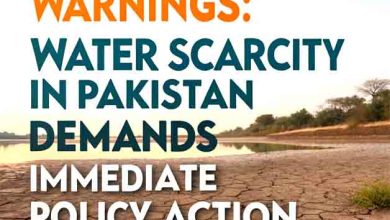Ecosystem: A Wake-Up Call
The whole country is vulnerable, but GB is more so
As time passes, the threat of climate change is becoming visible day by day. The globe is witnessing harmful impacts, and developing countries face the music more severely. Gilgit Baltistan is no exception. The region’s geography makes it more vulnerable to the disastrous effects of global warming. Gilgit Baltistan is home to the largest non-polar glaciers, including Siachen, Baltoro, and Hisper glaciers.
Global warming is increasing the rate of melting glaciers, causing floods, and disastrous effects are more severe each year. Rapid climate change poses a significant threat to the region’s delicate ecosystem, thus affecting people’s normal lives. Climate change results in various adverse effects on the ecosystem of the region. The rising temperature disrupts the natural habitat of various plants and animals and affects the pattern of vegetation and water sources. The changing pattern, severe rainfall, and heat psychologically impact the region’s inhabitants, and people live in constant fear.
We should encourage individuals, communities, and governments to work together to preserve the region’s natural beauty and protect its unique biodiversity. We must work with government authorities to raise awareness, implement sustainable practices, and support conservation efforts. We can protect Gilgit Baltistan’s ecosystem and preserve its natural beauty for future generations. Together, we can work towards a more sustainable and resilient future, ensuring that this precious region continues to thrive amidst the challenges posed by climate change. It is the situation of now or never to recognize the intensity of the situation before it’s too late
The region is known for its natural beauty: snow-capped mountains, lush green fields, crystal-clear streams, and eye-captivating lakes. Thus the habitat of the region is a source of tourism influx. However, changing weather patterns are disrupting the tourism industry. Unpredictable and severe weather events, including heavy rainfall, floods, and landsliding, pose dangers to travelers, making them less appealing to tourists.
Last year the Hassanabad bridge that connects Nagar and Hunza collapsed due to the glacier lake outburst flood (GLOF). This created a lot of trouble for the tourists and locals. Such incidents could result in heavy casualties, as happened in the Chamoli District of India, which took more than 200 lives. Thus the main source of income of the region, which is the tourism industry, could be affected badly in the future if the situation continues the same.
It is estimated that there are around 7000 glaciers in Pakistan, most of which are located in Gilgit Baltistan. Three of the World’s seven largest glaciers are sited in Gilgit Baltistan. Due to global warming, the rate of melting glaciers is increasing, causing floods and glacier lake outburst flooding(GLOF) threats. The whole GB has been identified as either a high or very high-risk region with respect to GLOF hazard. The head of the Pakistan Meteorological Department (PMD), Ghulam Rasool, mentioned in 2018 that the average temperature in the last 80 years in Gilgit Baltistan has increased by 1.4⸰C as compared to 0.6⸰C in the rest of the country. According to the Ministry of Climate, 3044 glacial lakes have developed in Gilgit Baltistan and Khyber Pakhtunkhwa. 33 lakes have been identified as prone to hazardous glacial lake outburst flooding. In a report jointly prepared by the Agha Khan Rural Support Program (AKRSP), National Disaster Management Authority(NDMA) and the Food and Agriculture Organization (FAO), it was mentioned that all three geographic zones of the district, located on the western edge of Gilgit Baltistan, are prone to hydro-meteorological hazards during spring, summer, and winter. The report added, “Floods happen every year or every second year and are the main causes of socio-economic disruption in the area. Important sources for these floods are glaciers and lakes situated at the higher altitude alpine zones. These sources cause flooding due to heavy rains, thunderstorms, and snow melt,”. More than seven million people are vulnerable to the threats of climate change in GB and KP.
This severe rainfall raises the risk of flash floods, devastatingly affecting communities and infrastructure. The natural habitat is affected badly, causing the endangerment of many species of the Northern areas, such as Himalayan ibex, markhor and snow leopard. Floods threaten human lives and damage agricultural land, homes, and vital infrastructure such as roads and bridges, further disrupting the region’s development and stability. The last year saw flood disasters in the Ghizer district and some other regions. The outburst of Shisper Glacier in Hunza devastated lands, homes, farms, and infrastructure. Due to these losses, locals migrate to other cities in Pakistan.
Certain efforts are needed at both the government and individual levels to protect Gilgit Baltistan’s ecosystem and address the challenges caused by climate change. High authorities should develop and implement strategies for ecosystem restoration, sustainable land management, and biodiversity conservation. As tourism is the major source of income, the government should encourage responsible and sustainable tourism practices that minimize the ecological impacts.
This includes educating tourists about the ecosystem’s fragility, promoting eco-friendly accommodations, and supporting local initiatives prioritizing conservation and community development. Since floods cause water shortages and drought situations, water management practices should be implemented to cope with changing water availability. Further, awareness campaigns should be conducted to educate local communities and tourists about climate change impacts, their consequences, and the importance of individual and collective action. Behavioural changes must be encouraged that reduce carbon emissions and support conservation efforts. In addition, we should discourage deforestation and put effort into forestation and planting trees as much as possible. The billion tree Tsunami project of Imran Khan deserves appreciation, and the current government should follow the same policies.
Climate change is a real threat. Still, many people in GB have no concerns over the intensity of the threat that awaits to show its more disastrous shape in the future. However, it is to be noted that the threat cannot be controlled if we leave all the burden on the government. Everyone must play their role.
We should encourage individuals, communities, and governments to work together to preserve the region’s natural beauty and protect its unique biodiversity. We must work with government authorities to raise awareness, implement sustainable practices, and support conservation efforts. We can protect Gilgit Baltistan’s ecosystem and preserve its natural beauty for future generations. Together, we can work towards a more sustainable and resilient future, ensuring that this precious region continues to thrive amidst the challenges posed by climate change. It is the situation of now or never to recognize the intensity of the situation before it’s too late.







